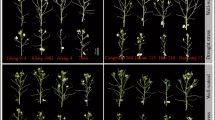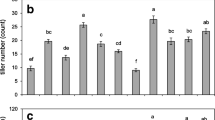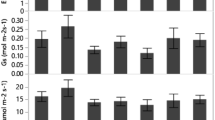Abstract
Fiber yield is reduced when ramie [Boehmeria nivea (L.) Gaud.] is produced under drought stress. Responses in Leaf morphology, root development and stem anatomy, and physiology of six cultivars, varying in tolerance to drought stress, were measured to identify plant characteristics for adaptation to drought stress. Ramie plants, established from 10-cm sections of shoots, were grown in pots with soil. When plants were 60 cm tall (about 40 days), moisture content in the medium was maintained at 55% of water-holding capacity for 28 days by weighing the pots and sparingly watering. Medium was maintained at 80–85% of water-holding capacity for the control. Drought-tolerant cultivars of ramie had more fine hairs on abaxial leaf surfaces, produced thicker leaf cuticles, better preserved leaf shape, and erectness, lost fewer leaves. They also generated longer roots with larger root masses and more storage organs, preserved higher root-to-shoot ratios, produced larger diameter stem vessels, and better conserved cell integrity than drought-sensitive cultivars of ramie when plants were grown under drought stress. Fiber yield was better in drought tolerant cultivars of ramie, because these cultivars had adapted root systems, leaf responses, cellular responses, and biochemical activities to allow plants to continue higher levels of photosynthesis and carbon deposition under more stressful environments than the less drought tolerant cultivars. Cultivars ‘Huangketong’ and ‘Qingkezi’ were best adapted to drought tolerance in the study.
Similar content being viewed by others
References
H.P. Adam J.E. Cairns P. Horton H.G. Jones H. Griffiths (2002) ArticleTitleLinking drought-resistance mechanisms to drought avoidance in upland rice using a QTL approach: progress and new opportunities to integrate stomatal and mesophyll responses J. Exp. Bot. 53 IssueID371 989–1004 Occurrence Handle10.1093/jexbot/53.371.989 Occurrence Handle11971911
Y. Anbessa G. Bejiga (2002) ArticleTitleEvaluation of Ethiopian chickpea landraces for tolerance to drought Genet. Resour. Crop Evol. 49 557–564 Occurrence Handle10.1023/A:1021210601480
L. Barbara A. Scartazza E. Brugnoli F. Navari-Izzo (1999) ArticleTitleAntioxidative defense systempigment composition, and photosynthetic efficiency in two wheat cultivars subjected to drought Plant Physiol. 119 1091–1100 Occurrence Handle10.1104/pp.119.3.1091 Occurrence Handle10069848
C.G. Cook K.M. El-Zik (1992) ArticleTitleCotton seedling and first-bloom plant characteristics: relationships with drought-influenced boll abscission and lint yield Crop Sci. 32 1464–1467
S.P. He Q.J. Yan G.Y. Song M.L. Xu (1995) ArticleTitleProgress in morphological and physiological and biochemical indexes of drought resistance identification of maize Agric. Res. in the Arid Areas 13 IssueID3 67–73
Y.W. Jiang B.R. Huang (2001) ArticleTitleDrought and heat stress injury to two cool-season turfgrasses in relation to antioxidant metabolism and lipid peroxidation Crop Sci. 41 436–442
Y.C. Jie P.S. Huang Z.D. Li (1998) ArticleTitleStudies on differences of genotypes in drought resistance and their mechanism of physiology and biochemistry in ramie China's Fiber Crops 20 IssueID1 1–6
K.P.B. Kavi Z.J. Hong C.H. Miao C.A.A. Hu D.P.S. Verma (1995) ArticleTitleOverexpression of A1-pyrroline-5-carboxylate synthetase increases proline production and confers osmotolerance in transgenic plants Plant Physiol. 108 1387–1394 Occurrence Handle12228549
J.S. Lan (1998) ArticleTitleStudy of comprehensive assessment method for drought tolerance of field crops Acta Agric. Boreal–Occident Sin. 7 IssueID3 85–87
Y. Li (1993) ArticleTitleAssessment method and indexes for drought resistance of crops Agric. Res. in the Arid Areas 11 IssueID1 91–100
A.L.S. Lima F.M. DaMatta H.A. Pinheiro M. R. Totola M.E. Loureiro (2002) ArticleTitlePhotochemical responses and oxidative stress in two clones of Coffea canephora under water deficit conditions Environ. Exp. Bot. 47 239–347 Occurrence Handle10.1016/S0098-8472(01)00130-7
F.H. Liu X.N. Liang S.W. Zhang (2001) ArticleTitleIdentification of drought-resistance by integrative utilization of drought-stress related observations in bio-physiology, morphology and anatomy for ramie Hubei Agric. Sci 3 16–19
Z.Q. Liu S.C. Zhang (1994) Physiology of Drought Resistance in Plants Agricultural Press of China Beijing 398
F.J. Sanchez M. Manzanares E.F. Andres Particlede J.L. Tenorio L. Ayerbe (1998) ArticleTitleTurgor maintenanceosmotic adjustment and soluble sugar and proline accumulation in 49 pea cultivars in response to water stress Field Crops Res. 59 225–235 Occurrence Handle10.1016/S0378-4290(98)00125-7
S.B. Singh R.G. Dani D. Singh (1992) ArticleTitleImproving drought resistance in cotton: a review Coton et Fibres Tropicales 47 289–300
Z.C. Tang (1983) ArticleTitleResponse and adaptation of plants to water stress Plant Physiol. Commun 3 24–29
H.Y. Wang Y.C. Jie A.P. Xiao (1999) ArticleTitleDifferences in proline accumulation of ramie genotypes China's Fiber Crops 21 IssueID2 27–29
Zhang B., Zheng C.Q. and Lin H.R. 1997. Study of the drought-resistance related physiological traits and agronomic traits of ramie germplasms under drought stress. China’s Fiber Crops 19(1): 26–30, 43.
X.Z. Zhang (1989) Investigation Methods for Crop Physiology Agric. Press of China Beijing 259
Author information
Authors and Affiliations
Corresponding author
Rights and permissions
About this article
Cite this article
Liu, F., Liu, Q., Liang, X. et al. Morphological, Anatomical, and Physiological Assessment of Ramie [Boehmeria Nivea (L.) Gaud.] Tolerance to Soil Drought. Genet Resour Crop Evol 52, 497–506 (2005). https://doi.org/10.1007/s10722-004-7071-3
Received:
Accepted:
Issue Date:
DOI: https://doi.org/10.1007/s10722-004-7071-3




